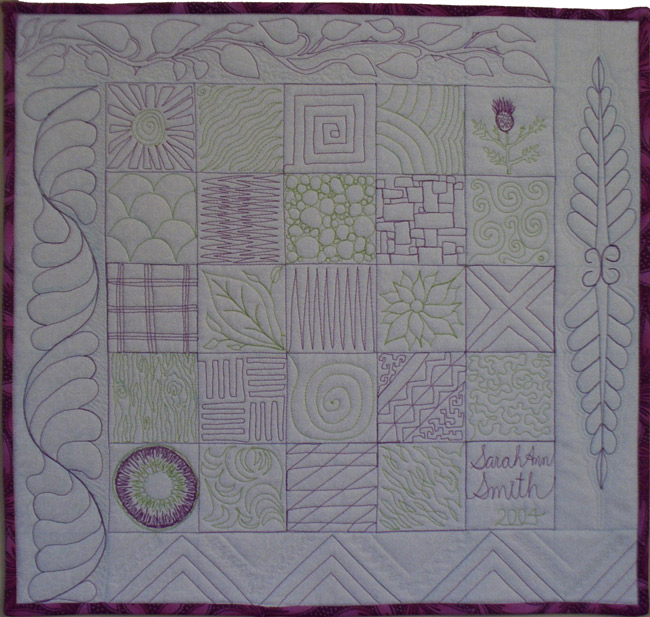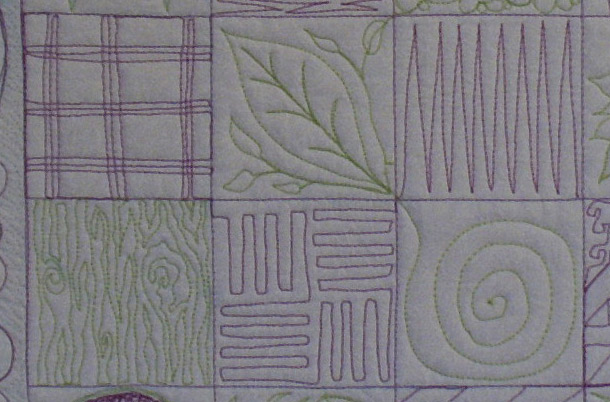Wobbly free motion straight stitches
A woman on one of my e-mail lists recently asked me a question, and I think (with the help of a good mechanic at a good store) I finally have an answer: why does one’s free-motion straight stitch sometimes wobble? Here’s an example that she spotted in my sampler in my book (good eye! and good catch). Look at the vertical lines in the upper left square..some wobble, some don’t (both photos are clickable for a larger view):
Here’s her original question, and portions of my replies. I think maybe we have at long last solved the mystery of the wobbly stitch. If anyone else has any good information, DO comment! This is how we all learn:
***Question:
Sarah,
I posed a question to the … group about a free-motion stitch problem I was having. Since I posted the question, I found your book (it had been “temporarily misplaced” in a sea of quilt papers) and was looking through it. I was particularly looking at your quilting stitches because I know you also use a 6600 and I see my problem in one of your stitch samplers. If you would, on page 91 of your book, the middle square on the left side, (sort of a windowpane design), look closely at the 3 center vertical stitches. I can see by the path of your stitches that the first line was stitched with the fabric coming toward you, the center line was stitched with you pushing the fabric away from you, and the 3rd line, again, was stitched with the fabric coming toward you. Do you see how the center line of stitching is much “cleaner” or neater looking than the 2 rows on either side of it? That is what is happening to my stitching, and it is making me crazier than usual. Do you think that is just something inherent in the machine?….. I have loved my 6600 up to this point and I can’t imagine using a macine with a smaller harp area, but I really need more precision than I seem to be getting. …..
[and a note from Sarah: the woman writing is a top award winning quilter, and was wondering how to improve her quilting having recently been plagued by some wobbles, and looked closely at both her work and mine in my book to see if she could find the answer…she used my example because it looked just like what was happening to her. I’m thrilled she asked, because we may have both learned something!… read on)
***My first answer:
I have yet to see a good explanation of what is happening, but I think it is a combination of two things:
going backwards isn’t always as smooth a movement as forwards
Stitching with the grain of the fabric (instead of on a bias)
I think the latter is they key thing…. it would be interesting to try doing 3 or 5 or whatever parallel lines on the straight of the grain, on the cross grain, and on the bias. I *think* that some of that wobbly look happens when you are free-motioning parallel to the threads of the fabric. If you go on a bias, not an issue… it has to do with which side of the weave of the fabric the needle enters …if you are stitching along one thread and the needle enters on one side of the fabric-thread on one stitch, then on the other side on the next stitch…
It isn’t just our machines… I’ve noticed this on many different brands when test-driving them…..
***And my second answer, thanks to Don at Tony’s Sewing Machines in Biddeford, Maine:
…. on the way to my teaching gig in NH last Thurs-Sat, I stopped in a really good sewing machine store in southern Maine for a totally different reason. The guy there seemed knowledgeable so I asked your question…. I have an answer, and it makes sense!
There are two reasons for the wobble [in a free motion straight stitch]… the first was my idea that the needle is coming down on opposite sides of the thread when you are sewing with the grain.
The second, more important, reason is that the needle bar on all zigzag machines must move. So it does!! When you free-motion, vibrations, the motions, etc. cause it to wiggle sometimes, leading to the variations in stitching. On straight-stitch only machines (like the Singer Featherweight which has the best straight stitch ever made because that is all it does), NO wobbling because the needle-bar is fixed/doesn’t move. The Mega Quilter is, I am pretty sure, a straight stitch only, so the needle-bar doesn’t move. On the Janome 11000 (top of the line) there is a special “locking” mechanism that locks the needle bar in place when set on a straight stitch, so that prevents the problem.
Makes sense, doesn’t it?
As for the mechanic with whom you spoke…. for sure when going in reverse with the feed dogs up there are issues, like on most programmed buttonholes, that is why the density of zigzag is different from one side to the next. The best programmed buttonhole I ever saw (I think it was my old Bernina …forget the number, but it was a fancy one in 1996) went down one side in forward, then stitched in reverse in a STRAIGHT stitch on the other side, then did the zigzag in forward on the second side, so the two sides matched perfectly.
Anyway, I think the reverse thing the repairman suggested doesn’t apply to free-motion,…. BUT the straight-stitch only machine / needle-bar that doesn’t move DOES make sense…..my guess is that by stitching on the bias, the wobble is disguised on our machines….
***As an addendum, it seems to me that reducing vibrations by slowing down and having a sturdy table/cabinet will minimize motion in the needle bar, and thereby reduce wobbles in the straight lines. Now, to go to a show with a practice quilt sandwichand test this theory out on a number of straight-stitch only and zigzag machines!



January 27th, 2010 at 10:13 am
Hi. Those tiny wobbles never really bothered me, but thank you for educating us all. Who would have thought! I have a JUKI 98QE which does straight stitching. I’ll have to observe the differences. Thank for following up on her question. And, to the sewing machine technician who had a real answer! Sally
January 27th, 2010 at 1:04 pm
VERY interesting! Thanks for sharing!
January 27th, 2010 at 8:23 pm
I read this post and can’t help think of the “quilt police” that we all think are checking out our work. It seems kind of sad that someone actually checks out the stitches on a beautiful quilt or even a sample in a book and finds the most minute flaws that are visible.
January 27th, 2010 at 10:12 pm
One thing that may minimize the lateral movement of the needle on machines that also zig-zag, is to use a plate with a straight stitch hole rather than the wide one that comes with the machine. I know that one was available for one of my older Pfaffs. Being aware of those varying sizes of the opening in the needle plate, I have on occasion narrowed it by sticking a piece of heavy tape over that area (keeping it clear of the feed dogs). This helps confine the lateral movement of the needle.
January 28th, 2010 at 9:55 am
That explanation absolutely makes sense. I do a lot of quilting on my Janome1600P which is a straight stitch only machine and am always happy with the stitch (not so happy that it is fussy about threads!)
January 28th, 2010 at 1:30 pm
The parts that assist with thread tension are located on different places around the sewing machine. For example, the part that controls the tension of the thread in the bobbin is called the “bobbin thread tension screw” and is located in the bobbin control case. The bobbin provides the thread that runs through the bottom part of the machine for sewing. The rest of the tension parts help control the tension of the thread that runs from the spool on top of the machine. The parts that control the upper thread include the slack thread level and the presser part release. The presser part release opens the upper thread tension. This helps the fabric that is being sewn to be removed more easily. The thread uptake spring helps keep the upper thread from breaking, despite any applied tension.
January 29th, 2010 at 11:16 am
Thanks for this post! Very interesting information. I will begin stitching on an exhbition piece in the next few days and this may allow me to keep my hair. (VBG) I will definitely be making some samples on my various machines (straight and zig zag) to look for “wobbles” before I decide which machine to do the bulk of the stitching on.
February 1st, 2010 at 10:33 am
Thanks for bringing this up!! I have noticed the same thing in my free motion stitching! I checked and it happens in both my Bernina and my Mid Arm straight stitch – so I think it is the fabric. I wonder if it happens more on densely woven cotton – ie hand dyed rather than normal commercial cotton??? I went back and checked my practice samples, that are on normal quilters cotton and I don’t see the wobbles. Thanks again – I’m mostly a lurker, but needed to add my 2cents….Mechelle
February 1st, 2010 at 5:04 pm
[…] Here is the original post: Art and Quilting in Camden » Blog Archive » Wobbly free motion … […]